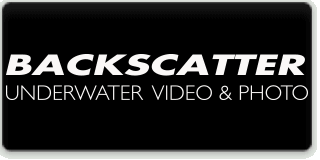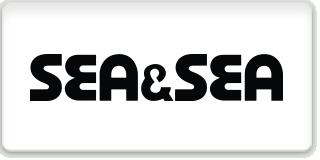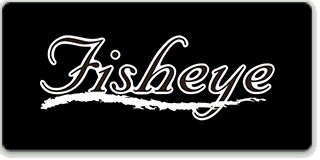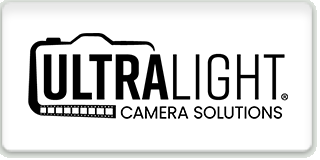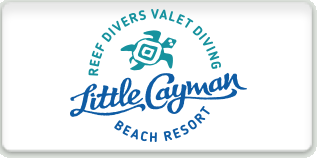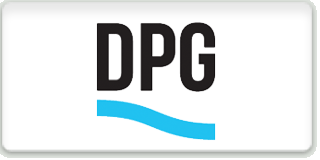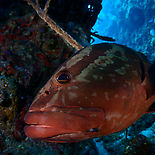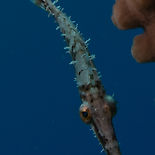GEAR TESTS: NIKON D800
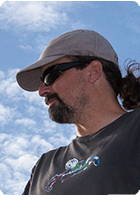 |
Berkley White Owner 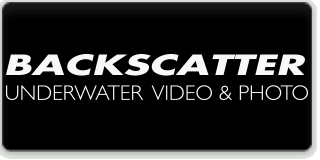 |

Testing the Nikon D800 in Video Mode:
I was able to squeeze the Nikon D800 and Nauticam NA-D800 housing from the firm grip of other Shootout and Backscatter staff for four dives. It felt great to get a Nikon body and menu system back in my hands after a few years of cutting my teeth on the Canon layout. Since I'm frequently asked about Canon vs. Nikon video performance, I spent my four dives shooting video.
White Balance:
In full disclosure, I went into this testing feeling a bit miffed that the Nikon white balance system lacks the accuracy and ease of use of the Canon bodies. However, once I looked at the raw footage I discovered the Nikon color to be very acceptable, but a little warm and pushing to yellow. The video I've shared is raw out of the camera and many of the close-up scenes have a yellow cast that I don't get with the same white balance techniques on a Canon body. I also find the blue water backgrounds to be a little pink or purple. The Nikon D800 has a menu option to calibrate white balance and I believe that one could fine tune the color over a few days. Overall it feels like Nikon is still in the video game!
Exposure:
Unfortunately, Nikon does not display the meter when the camera is in movie mode. I'm not sure of the logic behind this, but hopefully they will correct this omission with a firmware change. When shooting in bright ambient light it can be difficult to judge your exposure just off the image in the LCD. A quick glance at the meter bar can verify you're in the zone. I typically shoot in matrix metering and set my exposure to minus two thirds of a stop for average scenes.
Focus:
The Nikon D800 has very zippy focus, but as with all current DSLRs you need to lock focus prior to recording.
Nauticam NA-D800 Housing:
I was very impressed with the ergonomics of the new Nauticam NA-D800 housing. All essential controls were easily accessible from the right hand side. ISO has become an essential control for video and still shooters and the Nauticam housing features and easy to reach lever on the right hand side. The placement of this lever allows you to keep your hand on the handle and adjust ISO with only two fingers. The multi-selector control on the back of the housing mimics the look and function of the camera control. The mechanical design to pull this off looks very complicated on the inside, but it worked flawlessly and is easy on the fingers. Speaking of easy on the fingers, the housing latch system is tucked cleanly into the back of the housing body and is so smooth you'll never brake a nail just to get your housing open.
Zen DP-100 4-inch Dome Port:
I used a Sigma 15mm fisheye lens and the Zen DP-100 4inch dome port. The Sigma 15mm had its shade removed (cut off) to allow it to fit correctly in the small dome. I'd normally not use such a small dome for large scale wide angle, however since video crops to a 16:9 format, the typical unsharp corners are cropped out of the frame. I was really impressed by the sharpness of this combo, but I prefer the added buoyancy of a larger dome when shooting wide angle.
Summary:
I was very impressed with the video quality from the Nikon D800 and the ergonomics of the Nauticam housing. I believe it's a fantastic system for someone that shoots 70% photos and 30% video. With a little bit of practice and playing with the custom white balance options it would probably even suit a 50/50 photo and video shooter.
 |
Sterling Zumbrunn Chief Technical Officer  |
The D800 was one of the cameras I was most excited to test out at the Shootout. Earlier this year, I had the opportunity to try it out on land, and was blown away by the camera's resolving power when shooting landscapes. With an industry leading 36 Megapixels, the D800 now rivals entry level medium format cameras in resolution. I was anxious to see how this resolution could benefit the underwater shooter. How would the video fare compared to the D7000 and its disappointing white balance. These were some of the questions I hoped to answer with our testing.
On the stills side, it was more complicated than I first expected. The advantages of the added resolution were obvious when shooting macro. It was possible to shoot tiny subjects from farther away, crop the resulting frame, and still end up with at least a 10 megapixel file. The images have far more depth of field then would be possible if shooting them at close range. On wide angle, it was a different story. Only the best optics, the best dome port, and perfect technique will suffice. Anything else will not achieve the full potential of the D800's massive sensor. I turned to an old friend - the Sigma 15mm fisheye - which I know and love from extensive use of the Canon version - and the Zen DP-230 massive dome port. This combo yielded excellent results, but only when my focus was spot on. Even with the Sigma 15's massive depth of field, if I was even slightly off in setting my focus point, it is plainly obvious when reviewing the files at 100% view on my computer. Granted, for web use and even most print sizes, this won't really be as apparent, but if your goal is to use the massive resolution of the Nikon D800, you'll really need to take care with optics and focus.
As with the NA-D4 housing, the NA-D800 was a joy to use, with an excellent control layout, and all camera functions easily accessible. My one quibble with the housing is that it has only a single standard sized bulkhead due to a lack of space with all of the internal controls. This will be an issue only if you plan to use a video monitor and a hard-wired bulkhead, and even then you can substitue one of the fiber optic units with a mini-Nikonos bulkhead. I shot this camera with the Sea & Sea YS-250s, and never had an issue with the camera locking up. It was very responsive.
 |
Chris Parsons Sales Manager  |
I'd like to show you a lot of shots from the D800.... but the camera and housing were so popular in our demo fleet that I only managed to dive it myself for one dive during the Digital Shootout. I did, however, set up the camera for diving many many times, and can tell you that it held up exceptionally well to the abuse we gave it.
Nikon's D800 is a major upgrade from D700, and for those still shooting cameras like D200, D300 and D2X, the D800 is a whole new world. The most obvious and talked about feature is the resolution... an eye-popping 36 megapixels. For underwater use, though, the more overlooked and yet substantial feature is the unprecedented dynamic range. Combine that amazing sensor with fast and accurate focus and metering, and the result is a camera that will knock your socks off.
The Nauticam NA-D800 is a marvel in itself, offering ergonomic access to all key camera controls. Even though I didn't get time to know the camera that well, I felt right at home with the Nauticam housing. The same multi-controller that I mentioned in the D4 gear notes is here on the D800 as well, offering the same easy access to focus points. D800 has a pop-up flash, so fiber optic TTL is available in addition to hard wired sync. We switched between the two for the demo; most people opted for the fiber but a couple of sync cable diehards wanted to try it with their own strobes.
Not the best capture, but useful for showing the resolution - check out the Gorgonian image below and then view the 1:1 crop of the filefish.
Assembling the housing is so easy - nothing to pre-align; just attached the tray, lift the release dial slightly, drop the camera in and go. I did find that the little camera strap triangle on the left side can get in the way, so I'd recommend removing it or just double checking that it is in the downward position. Some of our demo users wanted to try the 45º viewfinder and some opted for the 180º version. NA-D800 comes with the brackets to reinforce the handles, but we removed those for the demo and mounting strobes right on the handles. For my own rig, I'd opt to remove them, but it is nice to know they are available if I wanted to mount some really heavy lights.
The resolution on this camera is astonishing. The only downside was that we weren't able to get everyone on the D800 system that wanted to try it. (I thought there was going to be a riot when the signup sheet filled up!). I wish we would have had two more D800 systems available for demo. Not to worry, though - if you didn't get a chance to demo the D800 at the Digital Shootout, check out our Spree Demo Days for another opportunity.
Nassau Grouper in a Swim-through; Nikon D800 with Sigma 15mm FE
Gorgonian with Slender Filefish; D800 with 15mm.
1:1 Crop of the Gorgonian with Slender Filefish; D800 with 15mm
READ MORE GEAR TESTS:

